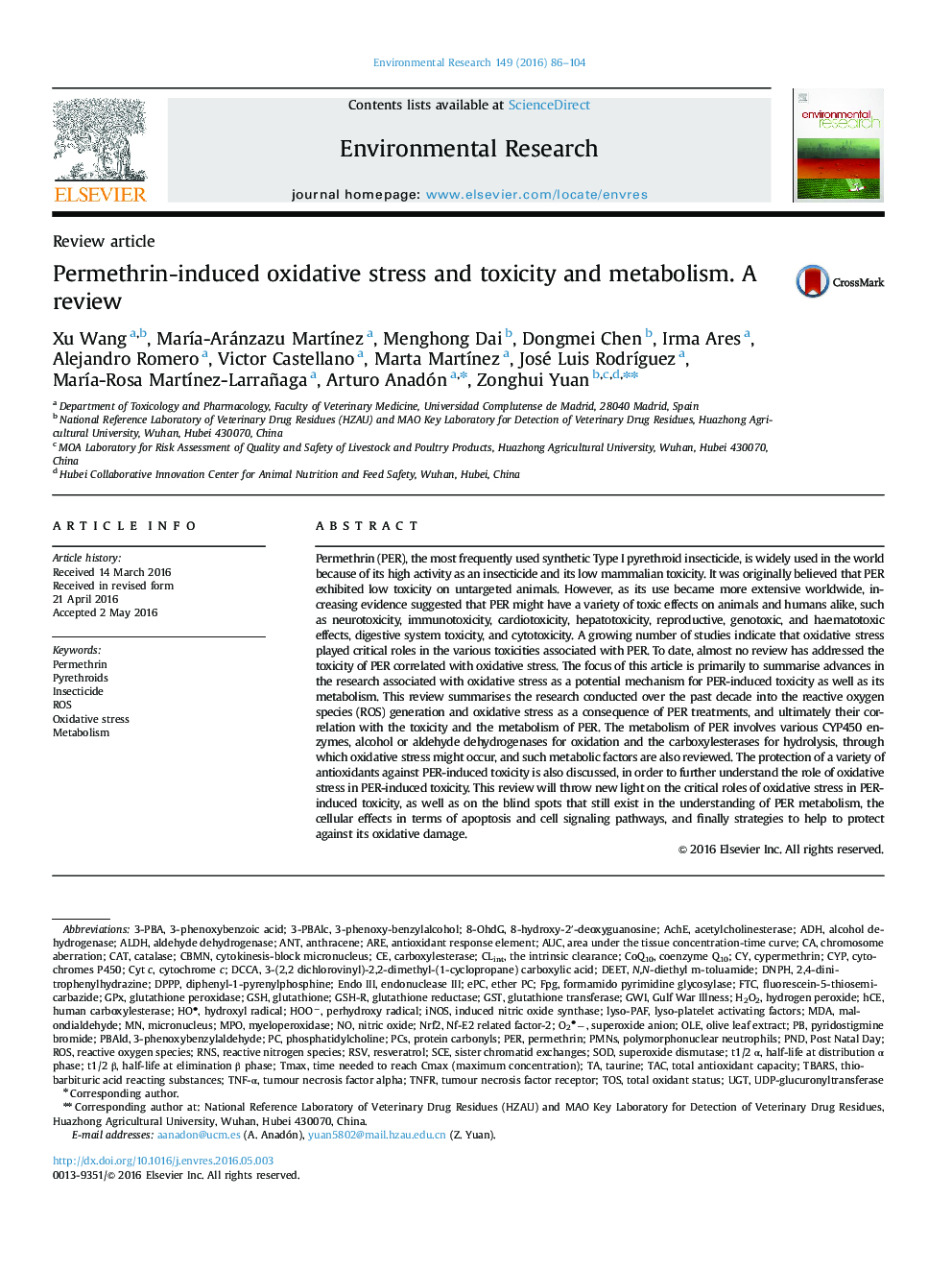| Article ID | Journal | Published Year | Pages | File Type |
|---|---|---|---|---|
| 6351428 | Environmental Research | 2016 | 19 Pages |
Abstract
Permethrin (PER), the most frequently used synthetic Type I pyrethroid insecticide, is widely used in the world because of its high activity as an insecticide and its low mammalian toxicity. It was originally believed that PER exhibited low toxicity on untargeted animals. However, as its use became more extensive worldwide, increasing evidence suggested that PER might have a variety of toxic effects on animals and humans alike, such as neurotoxicity, immunotoxicity, cardiotoxicity, hepatotoxicity, reproductive, genotoxic, and haematotoxic effects, digestive system toxicity, and cytotoxicity. A growing number of studies indicate that oxidative stress played critical roles in the various toxicities associated with PER. To date, almost no review has addressed the toxicity of PER correlated with oxidative stress. The focus of this article is primarily to summarise advances in the research associated with oxidative stress as a potential mechanism for PER-induced toxicity as well as its metabolism. This review summarises the research conducted over the past decade into the reactive oxygen species (ROS) generation and oxidative stress as a consequence of PER treatments, and ultimately their correlation with the toxicity and the metabolism of PER. The metabolism of PER involves various CYP450 enzymes, alcohol or aldehyde dehydrogenases for oxidation and the carboxylesterases for hydrolysis, through which oxidative stress might occur, and such metabolic factors are also reviewed. The protection of a variety of antioxidants against PER-induced toxicity is also discussed, in order to further understand the role of oxidative stress in PER-induced toxicity. This review will throw new light on the critical roles of oxidative stress in PER-induced toxicity, as well as on the blind spots that still exist in the understanding of PER metabolism, the cellular effects in terms of apoptosis and cell signaling pathways, and finally strategies to help to protect against its oxidative damage.
Keywords
ALDHEPCSCECyPCATPNDDEETDNPHNrf2UGTGSHGSTADHGPXTBARSTACANTiNOS8-OHdGCypermethrinRNSFTC3-PBA3-phenoxybenzoic acidDCCACytochromes P450Cyt COLEtmaxFPGPMNsRSVHCETNFRCoQ10TOSEndonuclease IIICBMNDPPPGWIFormamido Pyrimidine Glycosylaselyso-PAFNF-E2 related factor-2MDACytokinesis-block micronucleusfluorescein-5-thiosemicarbazideGSH-R2,4-dinitrophenylhydrazine8-hydroxy-2′-deoxyguanosineAUCMPOHO•O2•−ROSUDP-glucuronyltransferaseHydrogen peroxidealdehyde dehydrogenaseEndo IIIsuperoxide anionAChEAcetylcholinesteraseAlcohol dehydrogenasechromosome aberrationAnthraceneGulf War IllnessTaurinesister chromatid exchangesOxidative stresstumour necrosis factor alphaInsecticideperdiphenyl-1-pyrenylphosphineHydroxyl radicalPCsResveratrolpost natal daySODinduced nitric oxide synthaseSuperoxide dismutasecytochrome cTotal antioxidant capacityOlive leaf extractantioxidant response elementTNF-αphosphatidylcholinemalondialdehydeMetabolismmyeloperoxidaseMicronucleusPolymorphonuclear neutrophilsNitric oxideAREH2O2thiobarbituric acid reacting substancestotal oxidant statusPermethrinProtein carbonylsPyridostigmine bromidePyrethroidsCatalasecarboxylesterasehuman carboxylesteraseClintCoenzyme Q10GlutathioneGlutathione transferaseglutathione reductaseglutathione peroxidasereactive nitrogen speciesReactive oxygen speciestumour necrosis factor receptor
Related Topics
Life Sciences
Environmental Science
Health, Toxicology and Mutagenesis
Authors
Xu Wang, MarÃa-Aránzazu MartÃnez, Menghong Dai, Dongmei Chen, Irma Ares, Alejandro Romero, Victor Castellano, Marta MartÃnez, José Luis RodrÃguez, MarÃa-Rosa MartÃnez-Larrañaga, Arturo Anadón, Zonghui Yuan,
